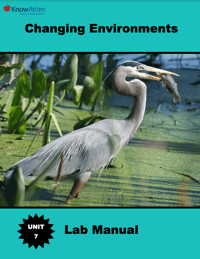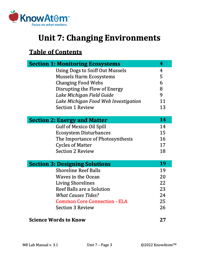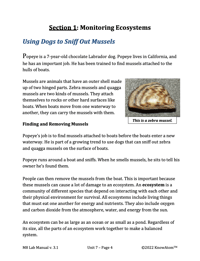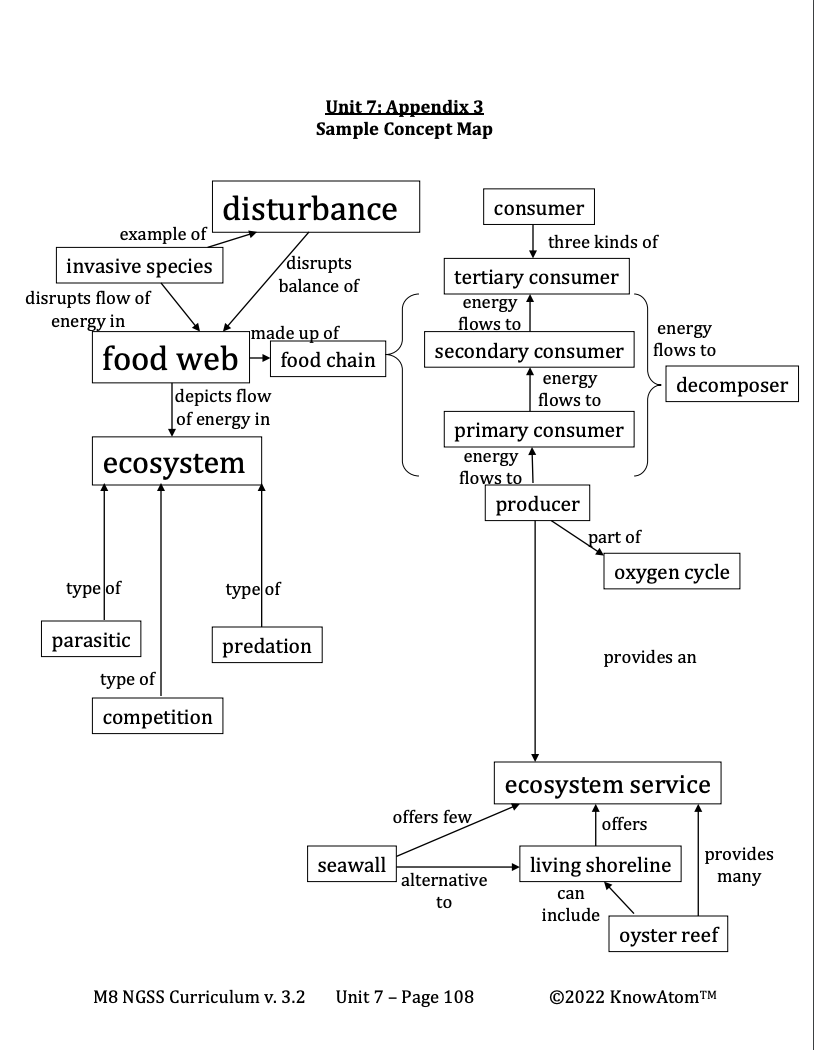Science background gives teachers more in-depth information on the science phenomena students explore in this unit. Below is an excerpt from this section.
Protecting Ecosystem Services
Invasive species and oil spills are both ecosystem disturbances. The loss of oyster reefs is another disturbance that affects many coastal ecosystems. Oyster reefs are structures formed by generations of oysters settling on top of one another. Oysters have been called “ecosystem engineers” because their reefs provide many ecosystem services. An ecosystem service is any positive benefit that an ecosystem provides to people. Oyster reefs maintain a tidal exchange by allowing the movement of water between the shoreline and the ocean. Oysters are also an important part of the marine food web. They are primary consumers, filtering plankton and algae from the water. They are a food source for hundreds of species of fish, birds, shrimp, and crabs. Their reefs are also habitat for many of these organisms as well.
The reefs have disappeared for many reasons, including overharvesting by people. Their disappearance has had a ripple effect across the food web, causing fewer organisms to survive.
Their disappearance has also affected a nonliving part of many ecosystems by causing erosion to increase. Oyster reefs help to protect the shoreline from erosion by absorbing wave energy as the waves move over them. This means that by the time the waves reach the shore, they have less energy. Without the presence of oyster reefs in some waterways, the coastline can erode at a fast pace as waves hit the land with their full force.
Waves, Erosion, and Seawalls
The most common waves are those caused by wind. As the wind moves, it transfers some of its energy to the water. This causes surface water waves. Some wind waves are small ripples across the water. Other wind waves can reach 30 meters (100 feet) high.
Tidal waves are different from wind-driven waves. Tides are the alternating rising and falling of the sea with respect to the land. They are caused by the gravitational pulls of the moon and the sun, as well as inertia as Earth rotates. Coastlines experience two high tides and two low tides every day. As the water moves up the coastline and then back, it erodes some of the rocks and sand as it moves over them.
Both kinds of waves cause erosion because they carry kinetic energy as they travel through the water. As the waves collide with the land, they transfer some of their energy to the coast. The stronger the wave, the more energy it transfers to the coast and the more erosion it can cause.
In response, many towns and property owners have built seawalls to protect the coast from erosion. A seawall is an engineered hard structure designed to protect coastal areas from erosion. The seawall blocks the waves and keeps them from reaching the coastline.
When the waves hit the seawall, they exert a force on the seawall. In response, the seawall exerts the same amount of force on the water. This is because for every action, there is an equal and opposite reaction. Action-reaction pairs occur whenever two objects or substances come into contact with each other. These action-reaction forces are what cause the waves to crash into the seawall and then back toward the ocean.
Seawalls can actually increase erosion because they reflect waves back toward the ocean. Because they redirect the wave energy toward nearby coasts, they speed up erosion all around the wall.
Living Shorelines
In recent years engineers have been looking for alternatives to the hard structure of a seawall. They have been exploring living shorelines, which are engineering solutions that use elements of natural habitats to maintain biodiversity and ecosystem services by reducing erosion and providing critical habitats for wildlife.
Some engineers look to natural oyster reefs for inspiration. Engineers have designed artificial structures offshore that provide some of the ecosystem services provided by oysters. One common solution involves artificial reefs. Engineers take a hard material, such as fossilized shells, limestone, or concrete, to use as a platform that oyster larvae can attach to. Some places have experimented with used tires. Over time, oysters and other organisms that attach to surfaces cover the hard material. This draws in small fish and other animals that are looking for food and shelter.
Reef balls are another technology that creates a living shoreline because each ball becomes a habitat for a wide range of marine organisms, including algae, barnacles, and oysters.
The reef balls also help to reduce erosion because they slow the momentum of the waves hitting the land. Momentum is the measurement of an object’s mass multiplied by its speed. Before the water collides with the coastline, it has momentum that depends on its mass and the speed at which it’s moving. An object’s momentum decreases when energy transfers out of it. When energy is transferred out of an object, it will have less energy to transfer during a collision.
Reef balls that have holes that water can pass through and come ashore. As the water passes through each hole, some of its energy is transferred to the reef ball. This reduces the wave energy and slows the wave’s momentum. Because there is less energy in the water that reaches the shore, sediments can settle, reducing the amount of erosion that takes place.








